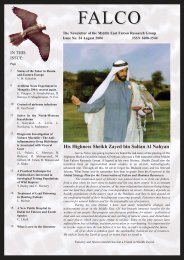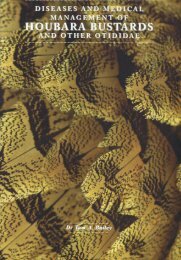Captive breeding and reintroduction of Arabian mountain and
Captive breeding and reintroduction of Arabian mountain and
Captive breeding and reintroduction of Arabian mountain and
Create successful ePaper yourself
Turn your PDF publications into a flip-book with our unique Google optimized e-Paper software.
pens <strong>and</strong> reducing visual stimuli that would otherwise promote attempted aggression between males<br />
through the fences. Tree <strong>and</strong> earth mounds provide a refuge for newborn gazelles from predators<br />
especially migrant eagles which can be present in large numbers at certain times <strong>of</strong> the year. Feeding<br />
<strong>and</strong> watering troughs are close to the entrance <strong>of</strong> the pen. The <strong>breeding</strong> pens hold <strong>breeding</strong> gazelles as<br />
well as single sex groups. Each <strong>breeding</strong> group is composed <strong>of</strong> 10 female <strong>and</strong> one male for Reem <strong>and</strong><br />
Gazella dorcas <strong>and</strong> 4 females <strong>and</strong> one male for Idmi gazelles (Kichenside <strong>and</strong> Lindsay, 1997). Gazelles<br />
feed on either fresh or baled alfalfa <strong>and</strong> a concentrate ration <strong>of</strong> gazelle pellets Superlac 16% (Arasco,<br />
Saudi Arabia). Each pen is provided with a mineral salt block in order to supplement minerals, which are<br />
needed by gazelles. In each <strong>breeding</strong> pen there is a capture facility in order to facilitate catching gazelles<br />
for different management purposes.<br />
Vaccination <strong>and</strong> Preventive Medicine<br />
Gazelles are normally h<strong>and</strong>led for vaccinations, sample collection for laboratory investigations <strong>and</strong> for<br />
other veterinary medical procedures. Gazelles at the Centre are vaccinated annually against Pest des<br />
Petits Ruminants (PPR), Foot <strong>and</strong> Mouth Disease (FMD) <strong>and</strong> clostridial infections. A blood sample is<br />
collected annually from all gazelles <strong>and</strong> subjected to ELISA TB testing. This test is undertaken because<br />
tuberculosis was detected in the <strong>Arabian</strong> oryx <strong>and</strong> gazelles at the early stages when the Centre was<br />
established (Rietkerk et al., 1992). Blood <strong>and</strong> tissue samples are also collected from gazelles for genetic<br />
studies. Faecal samples are collected from all <strong>breeding</strong> pens twice a year in order to check for<br />
gastrointestinal parasites. Gazelles are dosed annually with a broad spectrum anthelmintic in order to get<br />
rid <strong>of</strong> parasites. During the rainy season a prophylactic dose <strong>of</strong> sulpha compounds is applied in the<br />
drinking water in order to control coccidian parasites infecting gazelles (Mohammed <strong>and</strong> Flam<strong>and</strong>, 1996).<br />
Record Keeping<br />
The Animal Record Keeping System (ARKS) is the main database <strong>of</strong> the collection. Details <strong>of</strong> every<br />
individual gazelle are updated regularly. At birth newborn gazelles are caught by h<strong>and</strong> <strong>and</strong> fitted with a<br />
temporary small plastic eartag. Identification <strong>of</strong> the correct dam is facilitated by fitting <strong>breeding</strong> females<br />
with lightweight colour coded collars. The singleton males in each <strong>breeding</strong> group are known <strong>and</strong><br />
identifiable. A permanent metal tag is applied to all gazelles at weaning. All eartags <strong>and</strong> eartag numbers<br />
are related to an individual accession number for each gazelle registered within the ARKS package,<br />
where details <strong>of</strong> individual life histories are maintained by regular updates.<br />
Reproduction in Reem <strong>and</strong> Idmi Gazelles<br />
<strong>Arabian</strong> s<strong>and</strong> gazelles (Reem) are seasonal breeders. The rutting season in captivity starts late in<br />
October <strong>and</strong> early November. The observed gestation period is 155 days <strong>and</strong> the calving season starts<br />
late in March <strong>and</strong> early April. Over 90% <strong>of</strong> the Reem births in captivity are twins <strong>and</strong> in the wild 70%<br />
twinning has been observed in some seasons (Wacher <strong>and</strong> Kichenside, 1998). The <strong>Arabian</strong> <strong>mountain</strong><br />
gazelle (Idmi) are aseasonal breeders <strong>and</strong> they breed throughout the year. The gestation period is<br />
approximately 155 days based on the minimum interbirth interval <strong>of</strong> 167 days (Lindsay, personal<br />
communication). No twins were reported in Idmi births either in captivity or in the wild (Kichenside <strong>and</strong><br />
Lindsay 1997; Dunham, 1997).<br />
A project dealing with cyropreservation <strong>of</strong> semen from Reem <strong>and</strong> Idmi gazelles has been initiated in<br />
collaboration with the Reproductive Biology Department <strong>of</strong> the Institute <strong>of</strong> Zoology, The Zoological<br />
Society <strong>of</strong> London. The objective <strong>of</strong> this project is to study semen characteristics from Reem <strong>and</strong> Idmi<br />
male gazelles <strong>and</strong> have a genetic resource bank. This will help in any future work with regard to artificial<br />
insemination in <strong>Arabian</strong> gazelles.<br />
Reintroduction Programmes<br />
The need to reintroduce gazelles from captive bred populations was identified at an early stage by<br />
NCWCD <strong>and</strong> endorsed by an International Conference on Conservation <strong>of</strong> <strong>Arabian</strong> Gazelles (Greth et<br />
al., 1996). In line with conference recommendations, the International Union for Conservation <strong>of</strong> Nature<br />
<strong>and</strong> Natural resources (IUCN) guidelines for <strong>reintroduction</strong> were followed when planning the<br />
<strong>reintroduction</strong> programmes (IUCN 1995). Reem <strong>and</strong> Idmi gazelles for <strong>reintroduction</strong> are managed <strong>and</strong><br />
bred at KKWRC for this purpose. Key subsidiary recommendations in this approach to <strong>reintroduction</strong> are<br />
that only appropriate taxa are released within their former historic range <strong>and</strong> that the original cause <strong>of</strong><br />
extinction has been identified <strong>and</strong> controlled or eliminated. Gazelles reintroduced by KKWRC have all<br />
been placed into former range areas in newly created unfenced protected areas where ranger forces are<br />
present to prevent hunting. Extensive taxonomic research, including molecular genetics research, has<br />
been undertaken to ensure appropriate identification in this famously difficult group (Greth et al., 1996;<br />
Hammond et al., 2001).<br />
12




